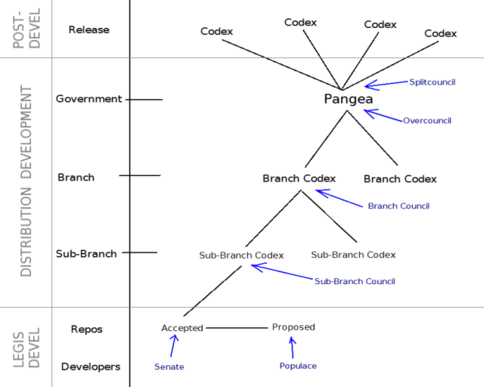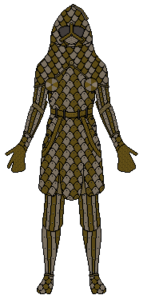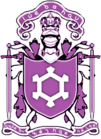Transitional Theodia
This article details the history of Theodia from around the time of the country's cession of Underwoodia, to just before the declaration of the provisional government; covering the time from November 2011 to May 2015. In the context of the greater MicroWiki(a) community, this places this period of Theodian history as occurring during and between the Inter-Summit Era and the Polarised Era. This period was a time of great change in Theodia, as the country gradually shifted from the Germanicist monarchy it was at its inception to the land of innovation that it is today.
Axellian Era

The Cession of Underwoodia
Though Theodia was declining again into inactivity by November 2011, it experienced a sudden, sharp rise in activity mid-month, when it annexed Underwoodia at its own request. Mr. Erasmas Drew Underwood was excited by recent Theodian innovations in the area of legislation, and rapidly began work on a new Theodian Region (Mentia), which was to be the first region to exist entirely online, and which was created out of the recently-acquired Underwoodia. Its Facebook page was buzzing, and Theodia's population jumped to eight. For the first time in Theodian history, representatives were selected to form a parliament. Unfortunately, only a week after it had so nobly begun, Mentia and the rise in Theodian activity came to a crashing halt, for Mr. Underwood had been disowned and banished from ser house. Because of this, Theodian parliament was unable to convene, and Mentia fell into desolation.
Proposed name change
Around 2011, it was proposed to rename the country to "Dautschland". This was derived from "Theodia"; went to <D> and <eo> to <au>, <tsch> was added to make it German-like, and <land> was added because it was a more Germanic suffix than <ia>. Had this occurred, citizens would have been 'Dautschlanders', the adjectival form 'Dautschlandic', and the language 'Dautschlandish'. This was proposed for the sake of uniqueness; 'Theodia' was used by more than just the Kingdom of Theodia, such as in the Catholic app Theodia, or in Dungeons & Dragons, where "Theodians" are a race of magical partiers.[1] This name change would also have provided unique forms for citizens, adjectives, and the conlang, as opposed to all being "Theodian". More, it would have strengthened Theodian ties with germanicist movements such as the Saxon Empire, Theodia's closest ally at the time.
Ultimately, it was decided to keep the name 'Theodia'. The distinctions between citizens, adjectives, and the language were deemed acceptable with all being 'Theodian', and the marginal benefits of maintaining the name 'Theodia' were considered to outweigh those of switching to 'Dautschland'. Further, Germanicism in Theodia had been on the decline since the waning days of the Violet Banner, and it within another year, it had all but disappeared, thus rendering the final of the 'Dautschland' arguments null. Indeed, in Theodia under the Cerulean banner, the '-ia' ending was considered a more relevant statement in language politics than 'Dautschland' was, due in part to '-ia's affinity to Spanish, which played a not-insignificant role in the Theodian lexicon, and due otherwise to the general cross-linguistic portability of the suffix.

Innovations
Although Theodia saw an overall decline in public activity during this post-constitutional period, its internal activity was higher and its innovation greater than many of the periods before it. The foundation of the Society for the Improvement of Humankind (SIH), Theodia's first think-tank, was particularly notable. One of the SIH's accomplishments was the creation of the world's first programming language designed solely for the purpose of writing laws: GOV. This effort was spearheaded by Swena, and it was hoped that GOV would make legislation clearer.[2] The SIH also developed several plans to reform education in the United States of America (this time at the behest of Axel). Another product of the SIH was a five-branch, tricameral government, which was intended to be become Theodia's constitution once it had been coded in the GOV programming language (another initiative of Swena's). While significant progress was made towards this end, with hundreds of lines of code written; the new constitution was never finished. The SIH also suggested that the Kingdom of Theodia, instead of passing an endless stream of laws, focus on continuously revising a series of "codeces". This would mean that there would be a single tax codex rather than an unmanageable number of tax bills. The SIH also pushed for the adoption of a regular release cycle, as is done with software. Both the release cycle and the "codex" idea were taken to heart, and later developed into Theodia's current legal system.
Unexpected burst of activity
Around the last week of March 2012, Theodia restored contact with the Saxon Empire. Around this same time, King Sweyn78 (now Swena) explained many of Theodia's recent innovations to several prospective citizens. Excited by Theodian innovation, several people applied for Theodian citizenship, and one of these citizens was the leader of the late Iskwania. With the intention of continuing the momentum Theodia had suddenly gained, Ser Grace, Kyng Sweyn78, declared the old constitution void and immediately began working on the long-awaited third (second) constitution of Theodia, which was originally expected to be completed within a week or so; but the development of GOV and the desire to write the constitution in that language ended up dragging development out indefinitely. Ser Grace, Kyng Sweyn78 also talked to M. Erasmus Underwood (later Axel Nielson) to see if se would be interested in continuing ser leadership of Mentia, something M. Underwood was excited by. Ser Grace, Kyng Sweyn78 hoped that a rebirth of Mentia would bring about a rapid increase in activity in Theodia, just as it had before. The Society for the Improvement of Humankind also expected a bright future when King Penda (Sean Anderson) of the Saxon Empire pledged the participation of the entire Runic Union in the think-tank. However, this participation never ended up happening.
Inactivity
Due to the intensity of Kyng Sweyn78's senior year of highschool, the months of April and May in 2012 were characterized by almost no activity in Theodia. It was expected that Theodia would come back in June, but due to Kyng Sweyn78's absence, this resurgence did not occur until July. During this period, Kyng Sweyn78 was working nearly nonstop on ser high school laureate project about linguistic relativism.
Rekindling the flame
In July, once Kyng Sweyn78 had started school at Florida State University, Theodia began to become much more active. Fairly regular meetings were held almost every day at 3:00PM EST on Facebook. By the end of August, contact had been re-established with long lost citizens and the Saxon Empire. Two ministerial positions were filled: Foreign Affairs and Culture, respectively by Axel Nielson and Paradox (the latter, unfortunately, resigned from ser position within a week of ser appointment).
Legislative advances
- Modlevels
- Although GOV was never completed, it did manage to obsolete something once thought integral to any modern government: a written constitution. This was done with the addition of modlevels to the language, which allowed legislators to make certain lines harder to edit than others. Essentially, under GOV, the only real difference between a written constitution and general legislation was that the constitution required more consensus in order to change. Before the introduction of modlevels, the constitution had to be done in one of two inelegant ways: a constitutional version of each codex or a unified constitution (this loses the benefits of the codex-system). The introduction of modlevels not only solved this problem, but allowed for several different modification requirements instead of just the single constitutional one.
- Optlevels
- While attempting to compile GNU coreutils from source one day, Kyng Sweyn78 discovered gcc compiler optimizations, such as the typical "O2". Since then, optimization levels have been added to GOV, and they allow legislators to specify how much optimization is necessary in order to do/change something. The higher the optlevel, the more research and testing is required to do something; the lower it is, the easier it is. This can be compared to VBR encoding: less significant parts of legislation have lower optlevels than more important parts of legislation. This helps to focus political research efforts on more important policies.
Mathematical advances
- Adoption of dozenal
- 12 (dozenal) became the official numerical base in Theodia, and thereafter became intrinsic to Theodian identity and culture. Dozenal was chosen over all other bases for its balance between divisibility (this makes most things involving fractions easier) and wieldliness (60 is the next-lowest number with more divisibility, but it's high-enough that it would be problematic to actually use). Theodian and Theodian English were each changed to count in dozenal, and work began on finding or creating a measurement system designed for dozenal.
- Adoption of ternary logic
- Ternary logic (using balanced ternary (
-*+)) was also made official, in contrast to more traditional binary logic. This had interesting implications for Theodian society. Binary is limited in the extent to which it can express uncertainty, instead leaving us with dichotomies such as "Guilty/Nonguilty", "Win/Lose", "On/Off". Ternary simply adds "Null/Unknown" to binary ("Guilty/Unknown/Nonguilty", "Win/Tie/Lose", "On/Unknown/Off").
Cultural advances
Inspired by Peyrdah, Theodia adopted amory in this period. Amory is a very decentralized model of relationships. With monogamy, a single unit is formed; with polygamy, a centralized network. With any sort of amory, all partners are typically quite politically equal. It further allows and indeed facilitates relationship changes with personal development on behalf of all parties as well as typically cleaner cessation or lessening of relationships than marriage. It is believed that this is a more natural way of living than strict, two person, lifelong marriages (especially considering the divorce rate in the West).
Changing of the flag
On the first of September in the Common Era 2012, five active Theodian citizens agreed to change the national flag to the now-iconic hex snowflake, after looking at a number of mockups, most of which were made only a day before. This was done so that the motto [Innovativeness, Industriousness, Integrity] would be better symbolized by the flag—the previous flag, an orange Scandinavian cross, had little to do with the motto. Originally, the flag was going to be a simple hexagon, but it evolved first into concentric hexagons, then into a subtle cube, and finally into a hexagonal cog shape—a variation of which has been on every Theodian flag since. Instead of the typical 5:3 ratio for flags, it was decided to use 16:9 as it is a ratio of squares and a standard for screens intended for media (in retrospect, 4:3 would have been better, since it better-approximates the human visual field). Immediately upon completion of the design, Theodian Minister of Foreign Affairs, Axel Nielson, ordered a copy of the flag online.

Min. Axel's suicide
On 2012-09-19, the Theodian Minister of Foreign Affairs, Axel Nielson (also known in the micronational community as "Erasmas Drew Underwood", and in the USA as "Drew Christopher Underwood"), took ser own life.[3] Many of Axel's contributions to Theodian society were never fully recovered, and ser loss lead to a temporary lull in activity as one of Theodia's most active leaders was suddenly gone. Ser passing also dramatically impacted Swena.
Post-Axellian Era
The wake
Theodia, in the immediate wake of Axel's passing, was a little disorientated. Kyng Sweyn78 signed a treaty that Axel had prepared with Lostisland, and also attempted to contact Axel's family to retrieve all the work se'd done, although they unfortunately proved unreachable. An older backup of the code Axel had written for the Theodian economy was later found in an email archive and stored safely in Theodia's official file directory.
For a time, with Axel gone and Sweyn's classes increasing in workload, Theodia became fairly inactive again. Contact was nevertheless maintained with Paradox, the leader of Tavadia and co-emperor of the Saxon Empire.
Activity resumed in early 2013 with the dawn of repositocracy and the Minecraft Initiative, as well as significant work on the Theodian language.

Development of repositocracy
The codex-system gradually evolved into a repositocratic one. Although repositocracy was never truly implemented in Theodia, the general structure of such a system was developed. It was to be a system of hierarchical repositories, with each branch being a sub-subject of its dominating subject (ex.: Government > Economics > Fiscal Policy). Legislation, often shortened to "legis" or referred to as "software", could be written by any citizen, provided its whole contents were publicly available at all stages of development -- ie, all legislation had to be open source. Repositocracy would have all the benefits of open source development, such as increased protection from bugs and from certain sneaky unwanted features.
All citizen-developed software would automatically enter the "Proposed" repository or its respective branch (for example, Fiscal Policy Proposed, Monetary Policy Proposed, etc.). All branches would contain such a Proposed repo, in addition to an "Accepted" repo. Citizens would be able to continuously and freely vote how much they like a certain piece of legislation by rating it on a 7-point Likert scale. Votes would be weighted per each person's experience in the area. For example, a macroeconomics professor's vote on economic legislation would be weighted more heavily than a person with no experience in macroeconomics. After a piece of legislation had a high-enough rating, it would have entered into its branch's Accepted repo.
There was to be a single dedicated council (termed the Senate) which developed legislation. All legislation developed by the senate would automatically enter into an Accepted repo, but it could still be moved to Proposed by the population if they rate it poorly enough. Although the Senate would be able to draft legislation, it would have no ability to pick what actually becomes law. Instead, there would be council for every branch, with each being representatively sampled from all citizens with a certain amount of experience in the branch's subject. Council members were to remain anonymous for the short whiles that they were in office, and their selection was to be staggered so as to provide stability. It was hoped that this, in tandem with the rating system, would minimized the amount of negative legislation produced by lobbying, bribes, crony capitalism, ignorance, etc. Council members would not be allowed to draft legislation, but they would be allowed to pick what software becomes law. Only software in an Accepted repo would be selectable.
As an example of how this all works, the Monetary and Fiscal Councils would select legislation from their respective Accepted repos. Next, the Economics Council would consolidate their changes to ensure that there'd be no conflicts. At the top of the chain, then Governmental Council would consolidate the Economics and Foreign Policy etc's respective codeces, again to iron out any potential conflicts. After a single, monolithic codex (termed "Pangaea") had been produced by this process, it would have been divided up into several categorized codices, for ease of use and readability. A new version of the country's distribution would have been made available every two Thirds, which was intentionally the same duration as OpenSUSE's development cycle.
The Minecraft initiative
Kyng Sweyn78 started the Minecraft Initiative in early March 2013, the goal of which is to construct a capitol city for the country. After much thought and planning, it was decided to locate the capitol in the middle of the ocean, both for ease of construction and parallels with real life; if Theodia were to ever expand on any real land, it would likely be via seasteading. The capitol went without a name for some time, and Sweyn78 started referring to it as "Lemuria" temporarily, at first, but it has since become the de facto name of the city. Lemuria was also the name of a mythical city in Golden Sun 2 and was accessed via water in the Sea of Time. Lemuria, Theodia, although online, is not a part of Mentia, but is instead its own regional entity.
The city is highly planned, with several important pieces of infrastructure. In the city center, the City Hall resides to the north, the Union Station to the east, the Pantheon to the south, and the University to the east. Beyond the university lies the fancy housing district, an area where only established architects with a clear vision are allowed to build. North and south of the city center are the regular housing districts, where there are in effect several minimal building codes in an effort to keep things looking nice. To the east of the Union Station is the Shopping Center, which is where the various businesses of Lemuria will be located. It is connected to both regular housing districts. Further eastward is the Industrial District, which is the heart of the city's production. Here are grown and produced crops and wares of all kinds, for sale at the nearby market. The far east of the city is the home of the City Power and Waste Processing facilities. From here, wires flow out to the varied infrastructure in the city, powering them in one of two ways: always on, or on at day or night. The waste processing plant, whose core is located below the seafloor, is the final destination of the many sewer lines in the city. It cleanly disposes of garbage in its giant furnace. The entire city is several blocks above sea-level, and can only be entered by way of train (routes lead to WinterHaven, Lethos, and the nearby fishing pier) or boat. The city may be entered by boat from any cardinal direction. Once through the gates and at the dock, visitors need only ride in an elevator to reach the city's center. The four entrances, however, are protected by a heavy portcullis at nighttime, so visitors must come either by day or take a train.
The city is still an early work in progress. It is being developed using dirtframing, which allows the architect to easily visualize and modify the project without having to use expensive and time-consuming materials until the final build. It is hoped that the city will serve as a center for Theodian language and culture, as well as considerably boost activity.
Residents of the city must hold citizenship in the Kyndom of Theodia. Businesses, however, do not have this restriction. Nor do those who build in the fancy district.
Since Minecraft costs money, it is not required for Theodian citizens to participate in the capitol city. Kyng Sweyn78 hopes that the city can someday relocate to an open source or a free-as-in-beer program with a similar feature-set so that all Theodian citizens may participate.
Introduction of Milic Measurement
The Kingdom of Theodia finally adopted a custom system of measurement. It was designed to solve many of the problems present in the Imperial and Metric systems, as well as being dozenal. It uses units which directly relate to real life (such as temperature being based off the human body and volume being based off the average size of a mouth), while keeping them easily scalable and convertible. It is currently still under development. It was later renamed to the 'Ergonometric system'.
The end of the kingdom
Between 2013's March and July, very little history was recorded, despite a lot happening in the country. There is, even so, a little bit of information known about this period. The Kingdom continued its adoptation of repositocracy, and continued its search for a foreign affairs minister. Naropa (later known as 'Narba') eventually volunteered in June, though accomplished nothing. Min. Naropa later stepped down from the position, on 2013-07-12, citing events going on in hirs life that would prevent hirs from being able to act as Theodia's Min-FR for the foreseeable future. The same day, Min. Paradox stepped up to the position and held it until se was released from the executive a day later.
Quing Sweyn78 reformed the executive office at this time. The old ad-hoc structure was replaced with an organized system of Ministries and Departments. Soon after, due to recommendation by Min. Naropa (at the time, Minister of Intelligence), a tentative super-fallback mode was created, which places the executive into an amorphous structure. Neither were of course cannonized at this point, since the country's legislation development hub was not yet operational.
Quing Sweyn78 also wrote the first versions of the new Theodian constitution, kernel, and the first kernel modules. They bootstrap and specify the country's repositocratic system, and allow for the Legis Devel Hub to function.
On 13-06-26, the kingdom officially ended, and the transition into a republic began. Unlike many other changes of government, there was no revolution. In fact, the citizens were quite content under the monarchy, and the transition was even started by the monarch. The modern Theodian Republic is not a different country replacing the old, but rather a continuation and evolution of the original country.
The early republic
This period of history represents the start of the Theodian republic. Although very little legislative work was done, tremendous progress was made in military and linguistic technology, and Theodia attempted for a time to enjoin itself more with the greater intermicronational community, an effort which largely failed due to lack of manpower. This period is considered to have ended with the passing of minister Naroba.
Naming reform
During the transition to a republic, Founder Swena enacted a naming reform. Under the new reform, name-changes were limited to once per Third (to take effect on the start of the next Third). All names are now in Theodian, and come with a native and romanized version. The handle/nick/short trichotomy was preserved, but modified so that the latter two regularly derived from the formest, meaning that each citizen had only to coin one name for heirmself.
Diplomatic events
Theodia was approached by Leylandiistan and Novum Angliae, and agreed to mutual recognition on 2013-09-19 and 2013-11-02, respectively.

Military advancements
Great strides in military organization and technology were made throughout this era. The mace was adopted and developed as the main infantry weapon, and two shields were developed: one for one-on-one combat, and one for formation fighting. The Mongolian draw was adopted as the standard draw for the Theodian bow, and the idea of D-strings was developed to further improve accuracy with this draw.
The majority of the advancements, however, were armor-related. At the start of the period, the standard armor was a lamellar curaiss, a buttonmail aketon and mantle, and a kettle helmet; by the end of the period, the armor had evolved into two versions: basic, and advanced. In general, Theodian armours focus on providing good protection, mobility, and comfort in hot, humid environments. Both seek to do this cheaply and canonically, with the basic set catering to what already exists on the market, and the advanced version ignoring this. All armor is designed with a simple camouflage pattern that performs well in many terrains, but especially so in the Floridian everglades.
Diplomatic events
Contact was restored with West Germania on 14-01-24, and the Principality of Seborga was recognized on 14-02-04.
Theodia ascended to the GUM as a provisional member on 2014-02-02, shortly before the enactment of its new charter, which Theodia signed and ratified on 2014-02-14. On 2014-02-16, the Republic of Theodia, being no longer legally able to maintain status as a provisional member indefinitely, opted to become an observer state until its governmental system would be comfortably operational. The country later left the GUM completely, as it was unable to consistently send delegates to observe meetings, and as attending the meetings was not particularly beneficial for the country. Theodia may rejoin at a later date, if it is able to completely commit to full participation in the organization.
Linguistic events
Some significant progress on Theodian was made in this period. Several conceptual problems were solved, allowing further work to be done in the language's grammar. Some decent strides were also made in regards to understanding the phonosemantic properties of phonetic features, the knowledge of which is essential to the way Theodian's lexemes are going to be derived. The language's phoneme inventory and phonology were overhauled and simplified, and the language's script was tweaked to accommodate these changes. Also, a cursive version of the alphabet was finally developed, as well as a braille version and a vertical writing version that was inspired by Hangul. Two viable patterns have been developed for the language's numerals, but no stable set of numerals has yet developed.

Min. Naroba's passing
Around 12:00 noon UTC-5 on 2014-02-16, Minister Naroba secretly took an unknown amount of methadone, which had been prescribed to one of hirs parents after a recent leg amputation. At 15:00, se was found dead in hirs room, having drowned in hirs own vomit. Se was rushed to the hospital, where se remained on life support for a week. They were able to get hirs heart beating again, and hirs brain stem was functional upon hirs revival. One of the first major threats to hirs life after this was the dramatic swelling of hirs brain, which, if unimpeded, would have destroyed it, thus ruining any hope for recovery; the doctors were thankfully able to get this relatively stable around Tuesday of that week, but only through constant administration of medication. An apnea test was also performed Tuesday; Min. Naroba managed to breathe twice in a minute. It was planned to administer a second apnea test Wednesday to see if there was any change, but Min. Naroba's sodium levels had risen too high, and this apnea test was unable to be performed until Monday of the next week. Hirs heart rate began to drop over the weekend, and by the time of the final apnea test, was only around 6BPM. In this final apnea test, Min. Naroba managed zero breaths in fourteen minutes, and was subsequently declared brain dead around noon on 2014-02-24. Se remained on life-support until 7:00AM on Thursday 2014-02-27, and was cremated. Se died at the age of 19. Se donated hirs organs, and is estimated to have saved 15 lives because of this.
Post-Naroban Theodia
The reformation of the Kalendar

In April 2014, the official calendar was redesigned to consist of 3 Thirds per year, and different calendars for different hemispheres of the Earth. The year-break occurred 1/3 of the year after the autumnal equinox for the northern hemisphere, and 1/3 of the year after the vernal equinox for the southern hemisphere; this was hoped to make a compromise between the seasons of the polar, mid-latitude, and tropical areas of the world. There were a couple intercalary days between each Third, and these were used as holidays.
The expansion of the bureaucracy
In 2014's August, Swena, in the interest of breathing new life into the republic, recruited several new citizens to serve as tribunes. These citizens were Musə, Praonə, Prenda, and Tilən. They were enthusiastic about participating in Theodian society, but due to limited time and direction, have thus far not contributed anything.
Refocusing on the language
The Theodian writing system, which had been thought to be fully developed, entered once more into a period of innovation. Though the individual glyphs themselves remained the same, the ways in which they are organized into syllables, lexemes, words, and sentences was overhauled. Ligatures no longer occurred solely artistically, when consecutive glyphs presented similar features to each other; but instead, all syllables were joined together. Dashes now separated lexemes, and larger spaces separated words.
As well, a hybrid a priori / IAL hierarchy for deriving the lexemes to be used by the language was developed, and many words were added to the language. This change marked an important paradigm-shift for the language, as it was realized that filling the lexicon almost exclusively with inherently meaningful words (sound-symbolic ones) was an uncompletable task. The language now uses a mixture of endonyms, internationalisms, iconisms, and randomly generated & phonetically ergonomic lexemes.
The nominal case system was also overhauled.
The development of the government
Much work has gone into developing theories of governance, but much of it remains unimplemented in the official legislative release, of which there has yet been only one. A second one has been nearly ready for release since mid-2014, but the work necessary to finish prepping it has never been done at a rate fast enough to keep pace with the changes in Theodian society.
Suspension of Mentia
Theodia more or less gave up on Minecraft as the future means of building Mentia, and placed the realm on ice until a superior programme could be found.
The sixth flag

An extraordinary amount of work went into creating the sixth national flag of Theodia, going through several minimalistic and romanticistic varieties. After having been worked on for nearly a year, the new flag was made official on 2015, April 22, the 5th anniversary of the country's founding.
Continued development of the armour
By May 2015, the armour had developed to its present state, with lamellae that do not expose their lacing, a splint helmet, and several other features.
See also
- History of Theodia
- Flag Model of Theodian History
- Foundational Theodia
- Maturational Theodia
- Repositocracy
References
- ↑ (Retrieved 2011). "Theodians". Dungeons & Dragons wiki, Wikia. http://www.dandwiki.com/wiki/Theodians_(3.5e_Race)
- ↑ GOV interview #by Peyrdə; Swena #from Google Drive #published 2012 #retrieved 2013-07 #deadBy 2016-01-08
- ↑ http://www.legacy.com/obituaries/news-leader/obituary.aspx?n=drew-christopher-underwood&pid=160040279#.UF8ddB6yOOM.facebook
